Forests of Odisha | Odisha State PSC (OPSC): Preparation - OPSC OCS (Odisha) PDF Download
Introduction
The state of Odisha, due to its geographical location and wide range of physical features, shows a diversified vegetation and forest cover. The state has different types of forests like tropical semi-evergreen forest, tropical moist deciduous forest, tropical dry deciduous forest and coastal or mangrove forest. These forests are important in terms of environment as well as economy.
Forests in Odisha are very rich and important which provide timber, pulp, herbs fuelwood and fodder. Forests also help in preventing soil erosion, increases soil fertility, reduce pollution, help in the precipitation and so on.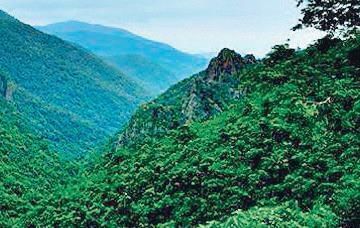
Recorded Forest Area in Odisha
As per India State of Forest Report, 2017, the recorded forest area of Odisha is 61,204.17 sq km which constitutes 39.31% of the state’s geographical area. Recorded forest area of the state is divided into three parts.
- These are: Reserved Forest Those forests which are permanently marked either for the production of timber or other forest produce in which right of grazing and cultivation is allowed are known as Reser ved Forests. As per India State of Forest Report, 2017, the reser ved forest area of Odisha is 58.90% of the total forest area.
- Protected Forest Those forests where the right of grazing and cultivation is subjected to a few minor restrictions are known as the Protected Forests. As per India State of Forest Report, 2017, the protected forest area of Odisha is 40.75% of the total forest area.
- Unclassed Forest Those forests which largely consist of inaccessible forests or unoccupied wastes, are known as Unclassed Forests. As per India State of Forest Report, 2017, the area of unclassed forests of Odisha is 0.35% of the total forest area.
Recorded Forest Area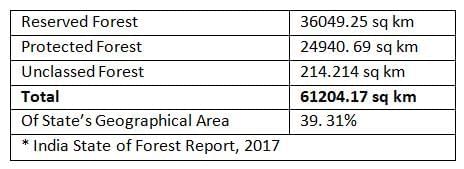
Forest Cover in Odisha
As per the India State of Forest Report, 2017, the forest cover in Odisha is 51,345 sq km which is 35.54% of the state’s geographical area and 6.90% of the India’s total forest cover area. Out of this, 6967 sq km is Ver y Dense Forest ( VDF), 21,370 sq km is Moderately Dense Forest (MDF) and 23,008 sq km is Open Forest (OF).
District Wise Forest Cover, 2017 (Area in sq km)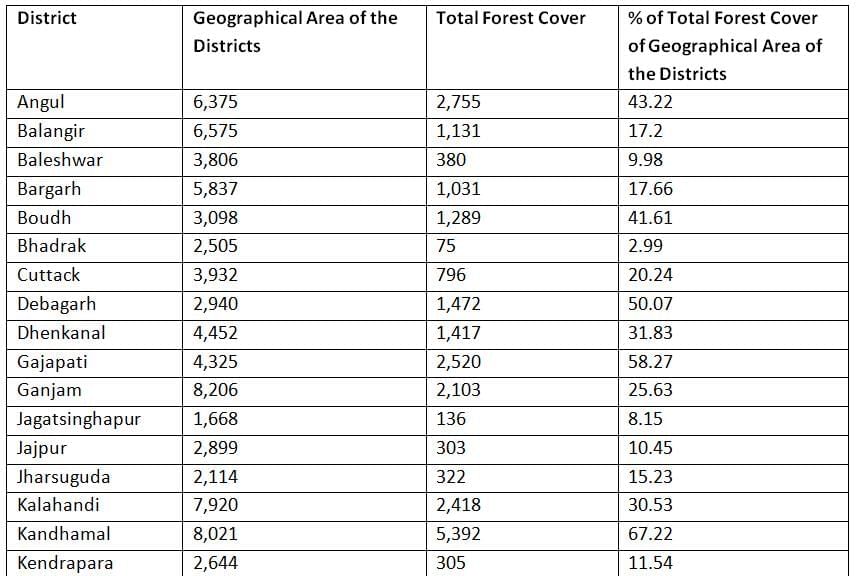
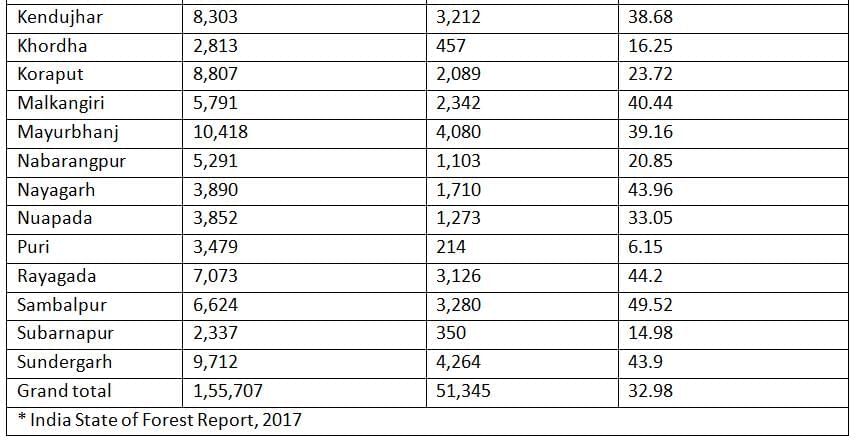
Classification of Forests of Odisha
According to Champion and Seth classification, 18 types of forests are present in Odisha. As per Forest Department of Odisha, on the basis of relief, rainfall and vegetation types, there are broadly four types of forests in Odisha. These types of forests are discussed below:
The Northern Tropical Semi-Evergreen Forests
- These forests are found in the lower hills and valleys of the state and found at an elevation above 600 m. These are found in the forest divisions of Dhenkanal, Athgarh, Puri, Mayurbhanj, Nayagarh, Parlakhemudi, Koraput and Kalahandi.
- In these regions, deciduous forests are top storey trees and remain leafless for a short span of time.
- On the other hand evergreen forests are second storey trees. Absence of bamboo growth is the most striking feature of these forests. Important tree species of these forests are mango, mankarkendu, arjun, champa, rai, nageswar and manda.
The Tropical Moist Deciduous Forests/Monsoon Forests
These forests are found in the lower elevations of Odisha like in Mayurbhanj and Keonjhar districts and also in the districts which shares their borders with Madhya Pradesh and Andhra Pradesh states. These forests cover the largest forest area of about 80% of the state.
These forests are divided into two major sub-types:
- Sal It is the most important species of these forests of Odisha. Sal is mostly found in the regions of North and North-East of the Brahmani river. It is also found in the East of Tel river and in the Sabari basin.
- Male Bamboo (Dandrocalmus strictus) and Thorny Bamboo (Bambus a arundinacea ) Other dominant species in these forests i.e. male bamboo and thorny bamboo are found in the forests of the Eastern Ghats, which mainly confined to the basins of Mahanadi and Rushikulya rivers. The uses of male bamboo are manufacturing of paper pulp and house building, fencing and making rafting material.
- Sal and other species like Kusum (Adina cordifolia), the Burra Ironwood (Xylia xylocarpa), the Dhan (Anogeissus latifolia) and the Hualtu (Machilus villosa) are met at heterogeneous deciduous zone. Here sal species fall short by 50% and gets mixed with the other tree species which are found in the moist deciduous mixed zone.
- This mixed zone is found in Keonjhar, West of Deogarh, Bhuban, East of Dhenkanal, Nayagarh, Parlakhemudi and Bhubaneshwar, Sonepur, Athmalik, and Phulbani. Important species of these forests are Sal which forms top canopy of the forests, Piasal, Kusum, Asan, Dhawra and Daba Bamboo.
The Tropical Dry Deciduous Forests
- This is the second most abundant forest found in Odisha. These forests are found in the drier Central and Western regions in parts of Balangir, Kalahandi, Sambalpur, Khariar, Gobindpur and Deogarh divisions. The upper Tel, Nagavali and Sabari basins in the Western and South-Western parts of Odisha also have these type of forests.
- Teak and Salia bamboo are mostly found in these forests. Important species of these forests are Teak, Sal, Salia bamboo and Daba bamboo.
The Tidal Mangrove Forests/Coastal Forests
- These forests cover the smallest area in Odisha. These forests are found in the sea-coast and found mainly in the Bhitarkanika, delta of Mahanadi, mouth of river Devi, mouth of river Dhamara, Budhabalanga and Subernarekha rivers.
- Bhitarkanika has the maximum mangrove forest area about 14,987 hectares.
- Mangroves are salt-tolerant plant species which are found in the inter-tidal regions along the creeks and estuaries near the coast on the river mouth. They can thrive on both freshwater and brackish water.
- These mangroves are found in a limited and scattered form in Kendrapada, Bhadrak, Jagatsinghpur and Balasore districts of Odisha.
- These are important as they protect the remote areas against cyclones, the entrance of sea water during tidal surge and also stabalise the coastal landmass against sea erosion.
- These forests can survive on both fresh water and brackish water.
- Due to varied species of creepers, canes and other minor types of trees the tidal forests of the Mahanadi mouth is known as the Little Sundarbans.
- Hental (Phoenixpaludosa) is the predominant species of these forests, due to which the mangrove forests are locally known as Hental Van.
- Important species of these forests are Sundari (Heritiera), Karika (Bruquiera), Bani (Avicennia), Rai (Rhizophora), Guan (Excoecaria), Palm and Coconut. Iron wood (Casuarina) plantation, which is found on the Puri coast, provides fuel to the people.
- A narrow strip of grassland is also found between the mangrove forests and the cultivated zone, which extends from Chilika lake to the mouth of the Mahanadi river.
Forest of the Eastern Ghats
- The Eastern Ghats stretch from the Northern Odisha through Andhra Pradesh to Tamil Nadu in the South. In Odisha, the hilly areas of Eastern Ghats have flat tops locally known as Pats or Mulis. The areas of these hill tops has very rich vegetation with sub-tropical and temperate species.
- With good soil, higher rainfall and altitude, valuable and ecological openings have been formed in Eastern Ghats in which medicinal and economical plants are grown. However, these forests face destruction due to mining.
Problems of Forests of Eastern Ghats
Some problems of forests of Eastern Ghats are given below:
- Podu Cultivation (Shifting Cultivation) This has resulted in the destruction of forests resources as well as soil erosion in the area of Bhuyia Pidh and Juang Pidh subdivisions of Keonjar, the Padwa region of Koraput, Paralakhemundi and Phulbani district.
- Rubber, Tea and Coffee Cultivation The cultivation of rubber, tea and coffee in Koraput and Keonjhar districts reduce forest cover and surface run-off.
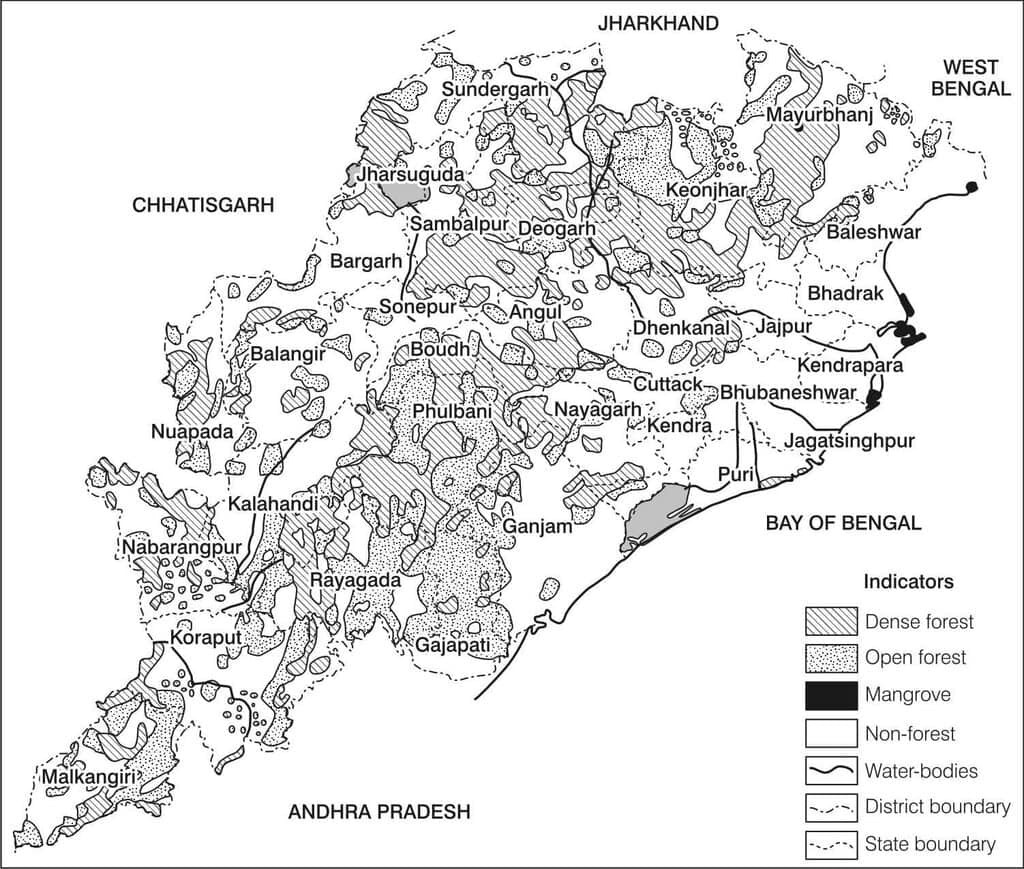
Forest Resources
Sal and its related species occupy 33% area of the total forest cover of the state. Bamboo occupies about 26% area of the forests of both dry as well as moist deciduous forests. Odisha has a number of resources from its forests.
These are discussed below:
Timber
- Timber species consists of Sal, Teak, Piasal, Bandhan, Kangad, Kasi, Asana, Sissu, Kusum, Bamboos, Kendu, Canes, Sandalwood, Myrobalan and so on.
- Sal and bamboo species are mainly found in Southern Odisha. Teak is mainly found in Koraput, Balangir and Kalahandi districts.
Tobacco
- Odisha is the third largest producer of Kendu leaves in India after Madhya Pradesh and Chhattisgarh.
- Due to large scale growth of bamboo, Odisha also produces paper. Bamboo found in tropical moist and dry deciduous forest are sources for paper mills concentrated in Cuttack and Rayagadh district.
Orchirds
- Orchirds are commercially very important in Odisha. It is estimated that out of the 1200 species of Orchirds of India, about 120 species are found in Odisha which include several rare species.
- In order to get the international attention, the State Government initiates programme to declare orchid-rich forests of Simlipal, Mahendragiri as Orchidarium which means an area dedicated to the cultivation of orchids. This helps in promoting tourism.
Medicinal Plants
- More than 200 medicinal plants have been identified in Gandhamardan hills in Odisha. Simlipal hills also has many significant medicinal plants.
- Important medicinal plants are Swasamari, Kochila, Korean,
- Thalkudi and Sarpagandha or Patalgaruda.
- Sarpagandha is an endangered and very useful medicinal plant which is found in the wild region of the state.
- It is mainly used as a traditional remedy for snake bite and cure for other diseases.
Aromatic Plants
- Kiya It is mainly found in Ganjam district along coastal Odisha.
- Sal Sal resin is used to extract, oil known as Chua oil. It is used as a fixative in heavy perfumes and for flavouring, chewing and smoking tobacco. It is also used in medicine as an antiseptic for skin diseases and for ear ache.
- Citrus Species These plant species are used for perfumery and pharmaceutical purposes. Their flowers, leaves and skin (rind) are aromatic.
- Vetiver This grass is grown in swampy areas and vacant land. Its roots are a good source of high grade perfumes. Lemongrass It is mainly used for thatching purpose as its oil is of very poor quality. Its varieties are found in cold hill regions of Koraput, Kapilas, Simlipal and Khariar areas of Odisha. Pignut or Chan (Hyptis Suaveolens) It is used as an edible oil in Gandhamardan hill areas of Balangir district.
Other Resources
- There are several resources obtained from forests in Odisha such as gum, resin, mahua, firewood, honey, etc.
Government Departments for Forest Development
Department of Forest and Environment Odisha
This department operates through a number of departmental formations and other autonomous bodies. The aim of this department is to provide protection, regeneration and extension of forest and tree cover in the state.
It also encourages the involvement of local people for the environmental management and conservation. This department follows the guidelines of the National Forest Policy, 1988, Odisha Forest Sector Vision 2020, and Joint Forest Management Resolution, 2011 for the forest management in the state.
Odisha Forest Development Corporation Limited (OFDC)
- It came into existence in 1990 by merging all forest corporations of the state. These forest corporations were Odisha Forest Corporation (1962), Simlipal Forest Development Corporation Limited (1979), Odisha Composite Board (1983) and Odisha Plantation Development Corporation Limited (1985).
- Its objectives are to exploit the state forest resources scientifically, to provide fair wages to forest labourers, to promote forest based industries in the state and to provide sufficient revenue to government.
Odisha State Forest Department
It came into existence during pre- independence period in 1883-84, when Odisha was a part of Bengal. In 1912, Odisha Forest Division was divided into two divisions, Angul and Puri. Sambalpur division was created after sometime. When Odisha came into existence as a new State and on 1st April, 1936, a new Forest Department was also formed. The department works in the development of state’s forest resources and implements many programmes to improve the forest cover of Odisha.
The primary objectives of this department are:
- Maintenance of environmental stability through preservation and restoration of the ecological balances where serious depletion of the forests happen.
- Conserving the natural heritage of the state by preserving the remaining natural forests.
- Increasing sustainability and the forest/tree cover in the state through massive afforestation and social forestry programme.
- Meeting the requirement of fuel wood, fodder, minor forest produce and small timber of the rural and tribal populations. Encouraging efficient utilisation of forest produces and maximising substitution of wood.
- Checking soil erosion and denudation in the catchments areas of rivers, lakes, reservoirs for mitigating floods and droughts.
- Checking the extension of sand dunes in and along the coastal tracts.
Government Initiatives for Forest Development in Odisha
- Sabuja Odisha Mission It is launched in November 2013. This mission has objectives to increase the green cover of the state by increasing forest and tree cover area, to conser ve and regenerate bamboo forests and to provide sustainable management to medicinal plants.
- Odisha Bamboo Development Agency (OBDA) OBDA has been formed to promote the bamboo sector in the State with special focus on commercial cultivation of bamboo in private land.
- State Compensatory Afforestation Fund Management and Planning Authority (State CAMPA), Odisha The state CAMPA was constituted during the year 2009 with the objectives of conser vation, protection, regeneration and management of existing natural forest, wildlife and their habitats, and raising site specific compensator y afforestation. The state CAMPA has so far formulated 7 Annual Plans of Operation (APO) starting with APO 2009-10. e- Green Watch Web-based monitoring portal e-Green Watch has been launched for monitoring and evaluation of all activities undertaken out of CAMPA funds in the state which are geo-referenced and uploaded into the portal.
- Ama Jungle Yojana (AJY ) This scheme has been launched with the objective of forest restoration, promotion, participatory forest management and improving livelihood of forest communities. The scheme is being implemented by Odisha Forestry Sector Development Society (OFSDS).
- Ekamravan at Bindusagar Ekamravan literally meaning one-mango-tree forest has been developed and maintained by city forest division, Bhubaneswar.
- It is situated on the western bank of the Bindusagar Lake adjoining the ancient Lingaraj Temple in the capital city Bhubaneswar. In this garden, medicinal plants have been exhibited with laterite and sandstone masonry of aesthetic and heritage design.
State Medicinal Plant Board The State Medicinal Plant Board has taken up the following activities during 2016-17:
- Created awareness on conservation, use, cultivation and marketing of medicinal plants. Conducted state and regional level Kalinga Herbal Fairs at Rairangpur , Bhawanipatna, Berhampur, Rourkela and Nawarangpur.
- Raising of free Home Herbal Garden will be provided support under 5 forest divisions of Berhampur, Balasore, Rourkela, Ghumsur and City forest division.
- Maintenance of medicinal plant garden over an area of two acres in Bhanja Bihar University by Berhampur division.
FAQs on Forests of Odisha - Odisha State PSC (OPSC): Preparation - OPSC OCS (Odisha)
| 1. What is the recorded forest area in Odisha and its significance for the state? |  |
| 2. How is the forest cover in Odisha classified and what are the key categories? |  |
| 3. What are the major types of forests found in the Eastern Ghats of Odisha? |  |
| 4. Which government departments are responsible for forest development in Odisha? |  |
| 5. What initiatives has the government of Odisha undertaken for forest development? |  |
















